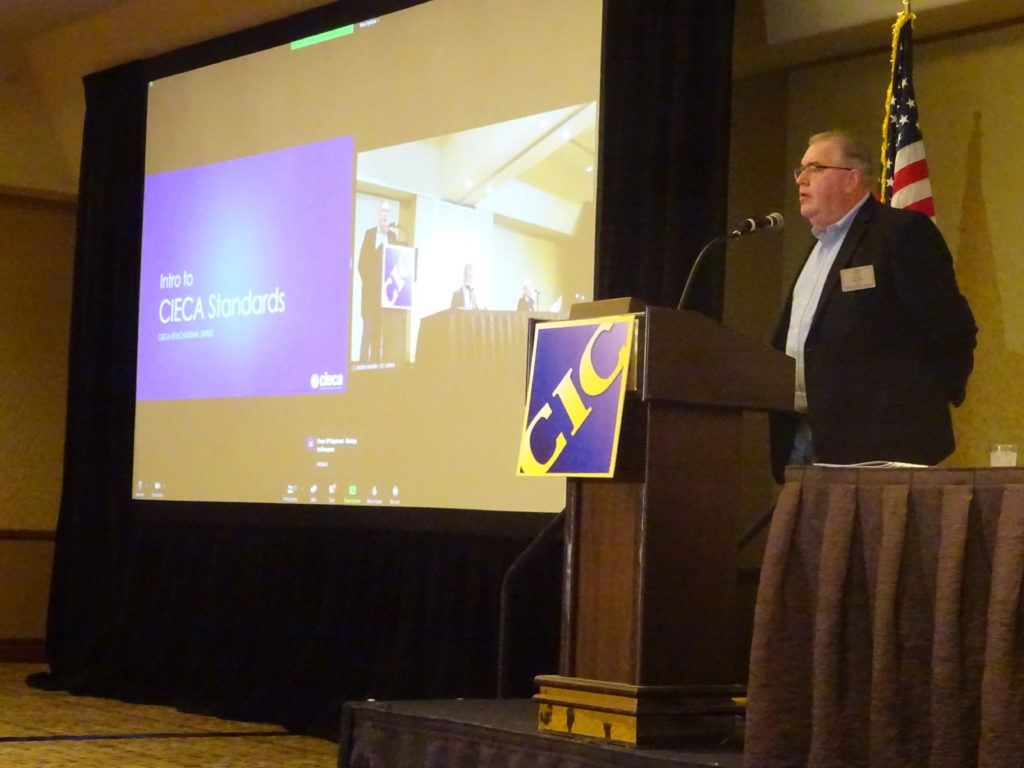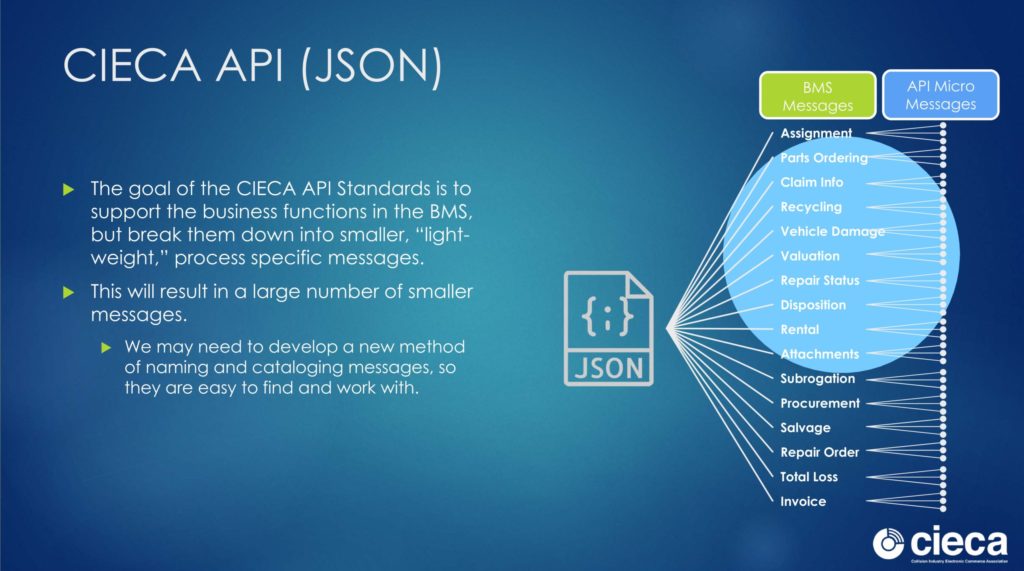
Estimating systems discuss body shops’ options for managing BMS communication
By onAssociations | Business Practices | Market Trends | Technology
A recent Collision Industry Conference presentation on the CIECA BMS data standard might get repairers interested in exchanging information with vendors that way rather than with the EMS format.
The older EMS standard of communication between repairer and business partner software relies finds the repairer submitting “exactly the content of an estimate,” Collision Industry Electronic Commerce Association Executive Director Paul Barry told the April 21 gathering. The other party gets to see everything on the sheet.
Barry’s organization CIECA is the neutral body which designs the digital standards permitting different collision ecosystem businesses’ software to communicate with each other. It created the EMS back in 1994 but hasn’t supported it for years. The organization has long since moved on to the BMS standard, which dates back to 2006.
The BMS standard is designed so a user can transmit only the parts of the estimate relevant to the other party’s industry. For example, a rental car provider doesn’t need to receive information about the parts ordered.
This is more efficient and allows greater data privacy, for information related to the customer and repair isn’t shared unnecessarily. According to CIECA, tailored sets of data can be shared for more than 200 business functions, and quite a lot of information is shared in some of them.
The BMS also generates more modern XML files, while the EMS transmits archaic dBase 4 files. (dBase doesn’t even support dBase 4 anymore, according to CIECA.)
But despite the benefits and CIECA’s urging to use the BMS format — Barry observed how CIECA would warn, “‘You’re sharing a lot of data you shouldn’t share'” — the EMS standard persists. In fact, it’s endured so long that it’s likely to be in use when CIECA introduces its upcoming third-generation of standards, despite Barry’s hope the new JSON-based format will “kill the EMS.”
Discussion following Barry’s comments suggested familiarity and a desire to avoid ceding control to a third party might be two of the factors fueling the EMS’ longevity.
Following Barry’s presentation to the Data Access, Privacy & Security Committee on April 21, Society of Collision Repair Specialists Executive Director Aaron Schulenburg posed a question he said an SCRS member watching remotely had texted him. (The CIC was held in a hybrid format, with some participants tuning in virtually and some physically present.)
The member expressed interest in the BMS, but asked how the data could be transmitted without going through an information provider, according to Schulenburg.
Schulenburg said sending a BMS “feels very different to a single-location shop” who lacks significant technology expertise.
Right now, an EMS file is simply exported to the repairer’s computer. A data pump installed by a vendor can automatically grab the estimate, or the shop can upload it manually. This raises security risks, including vendor data pumps siphoning off estimates for repairs they’re not even servicing. It also can stick the recipient with a bunch of irrelevant data they wind up up deleting, something that Barry said occurs in the industry. However, it’s an understood process, and it lets shop and vendors manage the process without having to rely on, learn, and consent to EULAs for one or more pieces of third-party software. Vendors might be particularly hesitant to rely on a third-party piece of software if it’s managed by a competitor.
Local exports
We asked the three estimating systems if there was a way a body shop could export BMS files locally and manage their transmission in-house in a manner like EMS.
Audatex/Solera: Audatex’s parent company Solera on Friday said it thought exporting files locally would represent a deviation from the BMS standard.
“Audatex is compliant with all CIECA standards,” Solera wrote in an email Friday evening.
“• The estimating applications support EMS 2.01 and 2.6 versions which, per CIECA, is a local file management model.
“• BMS standards dictate a secure API model rather than a local file exchange. As such, Solera/Audatex would not support downloading the BMS file locally as that would be contrary to CIECA standards.” (Minor formatting edits.)
According to CIECA, Audatex doesn’t need to be concerned about noncompliance here. Barry confirmed Sunday that local downloads would be OK under the BMS standard.
“(T)he CIECA standards do not stipulate if or how the BMS can or should be exported,” he wrote in an email. “The standard defines what the payload of the message should be…. not how it is transmitted. That is a function of the estimating & shop management platforms the shop uses.”
Barry told the industry summit last month that companies will tailor their BMS implementation to address specific customer requests or regulatory demands. He said the “key thing” was that anyone using the BMS framework was using “industry standard technology to communicate. And that’s really the important thing that keeps the industry able to operate efficiently.”
CCC: CCC said repairers and vendors would need to use its Secure Share software to exchange BMS messages, pointing out that exporting files locally would be less secure.
“BMS was designed to be easier to use and offer easier access to information,” CCC market solutions Vice President Mark Fincher said in a statement April 6. “BMS is simply a specification that outlines how the data should be structured and in what format. CCC ONE provides users with a secure environment to access, save, and share data important to conducting business. CCC Secure Share applies the BMS protocol and also includes additional levels of data encryption in a cloud-based solution, not available through the local export of data. CCC takes consumer privacy and security very seriously.”
Mitchell repair sales and service Vice President Jack Rozint said customers could export BMS files locally.
“Yes – we give out users the choice of EMS or BMS and allow them to have their own copy of the data in their chosen format,” he wrote in an email May 6. “They can work with their selected partners to manage the data and its security. In other words – yes, you can completely manage data in-house.”
Some Mitchell instructions on doing so can be found here and here.
EMS to BMS mapping
There’s another option for repairers and vendors to exchange information without relying on a third-party piece of software. CIECA offers instructions for mapping EMS into BMS.
However, this might not be feasible for smaller repairers lacking technical savvy or an IT department. Given CIECA’s desire to kill off EMS for good, we asked if the organization had considered developing and releasing a neutral piece of EMS-to-BMS mapping software the industry could use.
“There are no plans at this time to develop conversion software for EMS to BMS,” Barry wrote in an email May 7. “Not that it isn’t a good idea, but mainly because that falls outside the role CIECA plays in the industry. The mission of CIECA is to develop standards… not to develop or publish software applications. This may seem like a minor distinction, but CIECA is a member based non-profit association and the majority of our members are for-profit software companies. In my experience with CIECA it has never been CIECA’s role to develop software that might be perceived as being in competition with our members. A project of that nature would need to be sponsored and approved by the CIECA Board of Trustees.”
Letting the IP do the work
Now, as CCC has pointed out, benefits like cybersecurity and convenience can be realized by using a third-party system to exchange BMS data rather than each shop and individual vendor working out their own methodology.
“(W)ithin the CCC ONE platform, collision repairers are able to browse a listing of available apps and may choose to activate or de-activate sharing with those apps at any time,” CCC writes to repairers about Secure Share. It tells vendors: “CCC Secure Share opens up new possibilities for app developers and also reduces a lot of the pain related to the configuration and export of EMS files.”
So we asked Audatex and Mitchell if they offered a similar option for repairers who’d rather have their information provider facilitate BMS communication.
“Solera/Audatex offers a BMS Enterprise level integration via our B2B Integration Services,” Solera said. “Today, our insurance partners have leverage our BMS integration, and we have the capability to extend the implementation to repairers and vendors.”
“We don’t have the equivalent of Secure Share at this time,” Rozint said of Mitchell. “Instead, we allow our users to control the access to and security of their EMS/BMS data.”
JSON standards
As referenced above, CIECA will continue to support BMS but plans to develop the new JSON standards. Barry told the CIC these were “more granular” than even BMS gets, and he has in the past described the format as more efficient and popular for mobile device software.
We asked Barry if he saw EMS enduring even after JSON because of repairers’ inability to export and share files locally.
“There are a lot of reasons why EMS persists and the BMS adoption has been slow to replace it,” Barry wrote in an email. “As you state, part of the reason is that all of the estimating platforms export EMS but not all of them export an easy to use BMS. There are other factors that come in to play as well and one of our goals as we develop the new CIECA API Standards is to get a full understanding of those reasons. In the near future we will sending a survey out to the industry asking companies who have EMS and BMS implementations to help identify what obstacles they have experienced in the past so that if possible, we can address them as we develop the new JSON based standards.”
We also asked the information providers about JSON. Would those files be exportable locally by shops or transmittable through Secure Share or comparable Audatex or Mitchell systems?
Audatex: “Solera/Audatex’s BMS Enterprise level integration exchanges data via a secure API,” Solera said in a statement. “Per CIECA standards, Audatex does not support export of BMS files locally.”
“… Solera/Audatex has built online guides and videos that help the user with the configuration and use of the CIECA solution into the Qapter Estimating Help Center. Here is a link to a video on the YouTube Audatex Training Channel https://www.youtube.com/watch?v=W19DXd_UTYo.”
CCC: “CCC does not have immediate plans to implement JSON as part of CCC Secure Share,” Fincher said in a statement.
Mitchell: “We’ve always been a supporter of CIECA standards and expect to continue to support new and evolving CIECA standards,” Rozint wrote.
More information:
Collision Industry Electronic Commerce Association and Collision Industry Conference, April 21, 2021
CIECA “EMS to BMS Mapping” webpage
Images:
This Collision Industry Electronic Commerce Association slide presented to the April 21, 2021, Collision Industry Conference depicts how the EMS standard sends over the entire estimate. (CIECA slide; provided by CIC)
This Collision Industry Electronic Commerce Association slide presented to the April 21, 2021, Collision Industry Conference depicts the BMS framework. (CIECA slide; provided by CIC)
This Collision Industry Electronic Commerce Association slide presented to the April 21, 2021, Collision Industry Conference depicts the BMS standard’s XML licensing. (CIECA slide; provided by CIC)
Collision Industry Electronic Commerce Association Executive Director Paul Barry speaks to the April 21, 2021, Collision Industry Conference. (John Huetter/Repairer Driven News)
This Collision Industry Electronic Commerce Association slide presented to the April 21, 2021, Collision Industry Conference gives a sense of CIECA’s upcoming JSON-based standard. (CIECA slide; provided by CIC)





